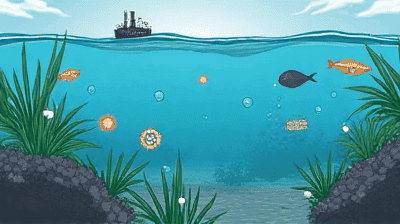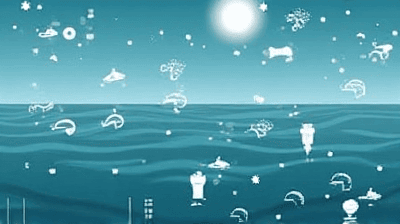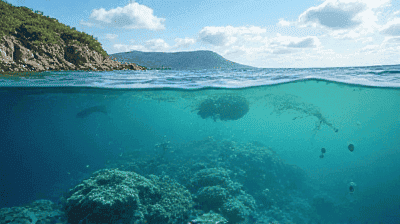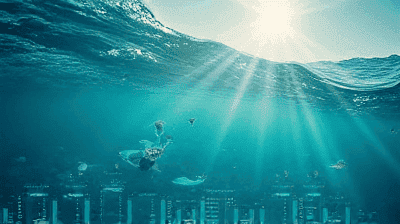
Microplastics, tiny plastic particles less than five millimeters in diameter, have emerged as one of the most challenging environmental pollutants of our time. These particles originate from various sources, including the degradation of larger plastic debris, microbeads found in personal care products, and synthetic fibers that shed from clothing during washing. As microplastics increasingly infiltrate marine environments, they pose significant risks to oceanic ecosystems, marine life, and, ultimately, human health. In response to this growing threat, effective wastewater treatment processes offer a crucial mechanism for filtering out microplastics before they reach the ocean.
Microplastics are defined as plastic particles smaller than five millimeters, which can sometimes be invisible to the naked eye. They are categorized into two primary types:
Primary Microplastics: These are manufactured products designed to be small, such as microbeads used in scrubs and cosmetics, or pellets used in industrial processes.
Secondary Microplastics: These result from the breakdown of larger plastic items, such as plastic bags, bottles, and packaging, caused by environmental weathering processes like sunlight, wind, and wave action.
Microplastics can enter the marine environment from various sources, including:
Wastewater Treatment Plants: Inefficient treatment processes can allow microplastics from household products and runoff to enter rivers and oceans.
Stormwater Runoff: Rain can wash microplastics from urban surfaces, including roads and other impervious surfaces, directly into waterways.
Direct Discharges: Industries that use or produce plastic materials may inadvertently discharge microplastics into the environment.
Wear and Tear: Synthetic fibers released from clothing during washing can break down into microplastics when they enter the wastewater stream.
Once microplastics enter the marine environment, they can persist for a long time. Their buoyancy allows them to float on the surface of the ocean, accumulate in gyres, and be ingested by a variety of marine organisms. Microplastics can absorb harmful chemicals and toxins from their surroundings, exacerbating their potential impact on marine life and food webs.

Microplastics pose significant risks to marine species, affecting their health, behavior, and reproduction. Many marine organisms, such as fish, mollusks, and crustaceans, ingest microplastics unintentionally, mistaking them for food. This ingestion can lead to various adverse effects, including:
Physical Blockages: Ingested microplastics can cause internal blockages or injuries, impairing digestive functions.
Toxicity: Microplastics can leach harmful chemicals, such as phthalates and bisphenol A, which may disrupt hormonal systems in animals.
Bioaccumulation and Biomagnification: As microplastics and associated toxins move up the food chain, they can accumulate in higher concentrations in larger predators, including commercially important fish and marine mammals.
The potential for microplastics to enter the human food chain raises serious health concerns. Consuming contaminated seafood may expose humans to harmful substances carried by microplastics. Emerging research is investigating the implications of microplastics on human health, including:
Toxic Leaching: Microplastics may release toxic additives used in plastic production, raising concerns about long-term exposure.
Inhalation Exposure: Microplastics can also be inhaled as airborne particles, presenting another pathway for human exposure.
Wastewater treatment plants (WWTPs) play a critical role in managing contaminated water from households and industries before it is discharged back into the environment. Effective treatment processes are essential for capturing microplastics and preventing them from entering marine ecosystems.
Preliminary Treatment: The initial stage of wastewater treatment involves screening and grit removal, where large particles and debris are filtered out. This process can remove some larger microplastics, but smaller particles often escape this stage.
Primary Treatment: During primary treatment, sedimentation tanks allow suspended solids to settle. This process further reduces the number of larger microplastics, though smaller and lighter particles may still remain in the effluent.
Secondary Treatment: This biological treatment stage employs microorganisms to break down organic matter. While this process is effective for organic materials, it can be less efficient at removing microplastics.
Tertiary Treatment: This advanced stage focuses on further cleaning the effluent and typically involves physical, chemical, or biological methods to remove remaining contaminants, including microplastics.
To improve the efficiency of microplastic removal from wastewater, various technologies can be implemented:
Membrane Filtration: This method employs semi-permeable membranes to separate microplastics and other contaminants from water. Options include microfiltration and ultrafiltration, effective in capturing particles much smaller than conventional treatment processes can manage.
Activated Carbon Adsorption: Activated carbon can adsorb microplastics and associated pollutants, enhancing water treatment. This approach effectively captures organic contaminants alongside microplastics.
Advanced Oxidation Processes: These techniques use reactive species to degrade organic pollutants and microplastics. Combining AOPs with conventional treatment can enhance the removal rates of smaller particles.
Biological Treatment Optimization: Enhancing biological treatment processes can improve the capture of microplastics. This may involve optimizing microbial communities that specifically target degradation or developing biofilms that can absorb microplastics more effectively.
Sweden's Wastewater Treatment Facilities: In various facilities in Sweden, advanced filtration systems incorporating membrane technologies have shown significant reductions in microplastic concentrations in treated effluent, resulting in a sustainable approach to managing plastic pollution.
Germany's Biological Treatment Innovations: German WWTPs have successfully integrated biofilm reactors tailored to capture microplastics, enhancing overall removal efficiency while maintaining effective biological treatment processes.
Canada's Research Initiatives: Canadian researchers are exploring the use of foam fractionation, a technique that separates particles based on their surface hydrophobicity. Early results suggest promising applications for capturing microplastics from wastewater.

Despite advancements in wastewater treatment technologies, several challenges remain in effectively addressing microplastic pollution:
Particle Size and Composition: Microplastics vary widely in size, shape, and density, making standardized treatment approaches difficult. Some smaller microplastics may evade capture even with advanced techniques.
Cost and Infrastructure: Upgrading existing wastewater treatment infrastructure to incorporate advanced technologies can be costly and resource-intensive. Many facilities may lack the financial capacity to implement necessary changes.
Public Awareness and Policy Support: Effective interventions to manage microplastics in wastewater require greater public awareness and policy-driven action. Coordinated efforts between governments, industries, and communities are essential for comprehensive management.
Ongoing research is critical for addressing knowledge gaps related to microplastics and wastewater treatment. Key areas of focus include:
Characterization and Behavior: Understanding the behavior of microplastics during wastewater treatment and their interactions with various treatment processes.
Health Impacts: Continued investigation into the potential health effects of consuming seafood contaminated with microplastics and understanding the implications of exposure to humans.
Policy Development: Advocating for regulations and frameworks to guide wastewater treatment practices aimed explicitly at microplastics removal.
Individuals and communities can play a significant role in reducing the introduction of microplastics into the wastewater stream. Strategies include:
Choosing Natural Products: Opting for personal care products, detergents, and cleaning supplies without microbeads or synthetic fibers can minimize microplastics entering the ecosystem.
Proper Disposal of Plastic Items: Engaging in responsible disposal practices can help limit plastic degradation, thus reducing source pollution.
Advocating for Change: Advocating for policies and initiatives that limit plastic production, promote sustainable alternatives, and support the implementation of advanced wastewater treatment systems.
Raising awareness about microplastics and their impact can foster collective action. Educational programs can emphasize the importance of reducing plastic use, promote responsible disposal methods, and encourage community involvement in local clean-up efforts.
Engagement with local government officials can enhance community-driven initiatives. Partnering to raise awareness around plastic pollution, support infrastructure improvements, and advocate for the implementation of sustainable practices can lead to systemic change.

Microplastics represent a complex and pervasive challenge for marine environments and human health. As they continue to accumulate in oceans, understanding the sources and impacts of microplastics becomes paramount for effective management and remediation. Wastewater treatment presents a vital pathway for capturing microplastics before they reach our oceans and exacerbating environmental degradation.
By advancing treatment technologies, improving infrastructure, and fostering community awareness, we can significantly mitigate the effects of microplastics on marine ecosystems. Furthermore, a collaborative effort among governments, industries, and communities is essential for addressing this pervasive issue, ensuring that the oceans remain a safe and healthy environment for future generations. The journey toward cleaner oceans requires collective action, innovative solutions, and a commitment to sustainable practices that prioritize our planet's health and well-being.